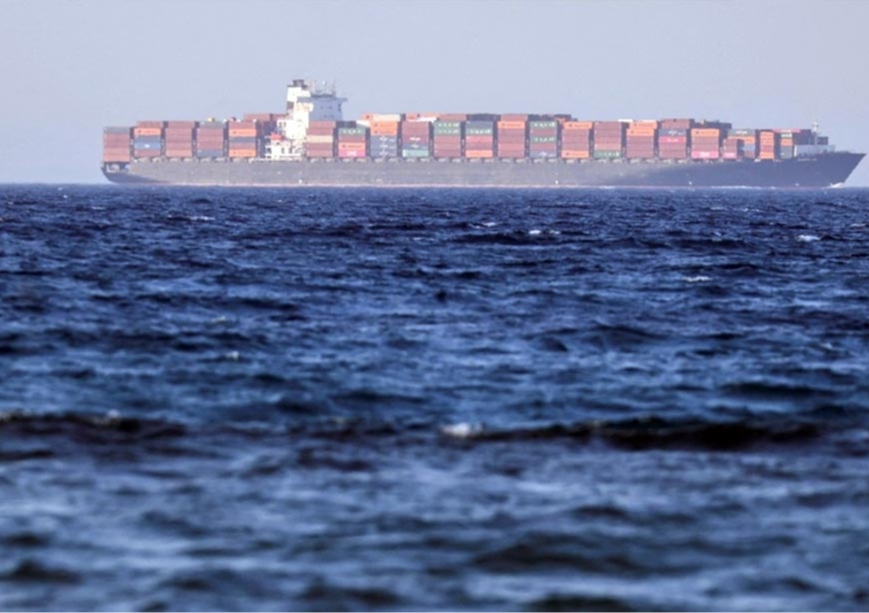
The Bab al-Mandab strait, south of the Red Sea, is a critical maritime choke point in the larger East Coast North American maritime corridor (ECNA), which connects Asia with eastern ports of North America through Europe. The ECNA comprises critical maritime chokepoints such as the straits of Malacca, Bab el-Mandeb, and Gibraltar as well as Suez and Panama canals. Close to 58 percent of global trade traverses through this corridor, marking its significance in global maritime trade.
However, with the Israel-Hamas conflict expanding beyond its littoral regions, to the Bab el-Mandeb Strait and the Suez Canal, the Red Sea is added to other maritime chokepoints—Strait of Gibraltar, and Panama Canal—of this essential maritime corridor.
Between December 2023 and March 2024, the Yemeni Houthis, a part of the larger self-declared ‘Axis of Resistance’—comprising Iran, Hamas, Lebanon’s Hezbollah and Iran-backed militias in Syria and Iran—have bombed over 44 ships traversing the Red Sea. Consequently, the United States-led ‘Operation Prosperity Guardian,’ a naval coalition of 20 countries, has augmented the US Combined Taskforce 153 (under the Italian Navy’s command since April 3, 2024) to counter Houthi interference in this critical maritime route.
The ECNA comprises critical maritime chokepoints such as the straits of Malacca, Bab el-Mandeb, and Gibraltar as well as Suez and Panama canals.
Military operations by the US and its allies and the Houthi rebels’ actions have brought down the commercial ships traversing the Red Sea from 50 ships a day in November 2023 to hardly eight ships every day in February 2024, thereby revealing the fragility of maritime supply chains and their geoeconomic weaponisation for applying pressure. This article analyses the impact of the Red Sea Crisis on the global shipping industry and Just in Time (JIT) manufacturing industries. It also delineates the fragility of global supply chains in the wake of the Red Sea crisis.
Prologue to the gathering storm
Traversing the Red Sea is the shortest sea route from Asia to Europe. Close to 15 percent of international shipping traffic, amounting to US$ 1 trillion/year, 33 percent of global container traffic amounting to 1,500 commercial vessels monthly, 10 percent of global oil supply (8.8 million barrels per day) and 8 percent of global gas supply transits the sea. The Red Sea transit channel is also critical for JIT industries such as perishable goods, automobile manufacturing, chemical manufacturing, semiconductors industry and most of all the shipping industry itself. This woe comes when global manufacturing saw a 12 percent uptick in the third quarter of FY23, thereby, already stretching the demand for containers, cargo ships and container vessels.
Short-term price hikes and delays in global maritime trade can also be directly attributed to the Red Sea crisis. Since December 2023, container vessels and ships have been traversing the longer Cape of Good Hope route to reach Europe, adding 4,575 nautical miles (29 percent increase) and 12-14 days of extra sailing to reach the North-Atlantic and European destinations. Moreover, a longer sailing distance has increased the fleet capacity traversing the route from the usual 11 ships to 23 ships for every round trip. Additionally, insurance premiums have ballooned to 2 percent of total shipment value (from 0.5 percent); fuel cost has increased to US$ 2 million per trip and overall costs for a round trip from China to the Netherlands (for instance) have increased by 250 percent on average. The resilience of the global shipping industry and some container/commercial shipping overcapacity have cushioned the impact for now. Still, the long-term implications of the crisis may not only include an increase in global inflation but also an enduring impact on JIT manufacturing industries.
The Red Sea transit channel is also critical for JIT industries such as perishable goods, automobile manufacturing, chemical manufacturing, semiconductors industry and most of all the shipping industry itself.
JIT industries are already reeling from the delays and increased costs due to the Red Sea crisis. Multinational companies such as Tesla, TATA Motors, Gechem GmbH & Co KG, Suzuki, Volkswagen, Michelin, Dunlop etc. These companies procure chemicals, automobile parts, microchips and refined critical metals from Asian markets. The sudden disruption to their critical value chain has forced them (and many other companies) to halt production and assembly lines or temporarily close their factories. Additionally, Europe’s chemical sector and the manufacturing sectors of economies like the United Kingdom (UK) and Germany are registering declining manufacturing output, due to the supply chain bottleneck. In February 2024, 4 of 5 sub-indicators of the Manufacturing Purchasing Manager Index (PMI)—a macroeconomic indicator detailing the state of the manufacturing and services sector of an economy—registered low numbers on a Year-on-Year basis for Germany and the UK. Effects of the Red Sea supply chain disruption rippled as lagging production and a fall in new orders. Notably, these economies were already under stress due to multiple macroeconomic problems, primarily in the manufacturing sector.
Despite these problems, for the time being, global commodity prices largely seem to remain insulated from the crisis. However, the continuous maritime rerouting is emerging as an issue for major trading nations such as India, the European Union (EU), China and the Netherlands which export-import several commodities through the Red Sea, oil and gas chief amongst them. Nearly 80 percent of China’s and India’s EU exports (US$ 559 billion and US$ 200 billion) also pass through the Red Sea annually.
The impact on Indian supply chains and economy
By volume, 80 percent of India’s external trade (50 percent exports and 30 percent imports) passes through the Red Sea. India exports perishable goods such as grains, rice, wheat, condiments and spices, amongst other goods and imports fertilisers, capital goods, oil and gas from West Asia and Europe, through this transit route. However, with the Cape of Good Hope rerouting and the sustained blockade in the Red Sea, there may be implications for India’s supply chains.
The cumulative effects of higher transit costs, sailing time, and insurance premiums can impact the costs of critical commodities such as oil, ancillary automobile parts, fertilisers and capital goods in the longer run. Shipping delays can also lead to unwanted inventory buildup for capital goods and sustained delays in fertiliser shipments from West Asia (primarily potash and alum from Israel, Jordan, and Egypt) can impact agricultural production in the longer run.
New Delhi’s Russian and Iraqi oil imports doubled in these four months, which are bound to get more expensive since they transit the longer Cape of Good Hope route.
These hypotheses are evidenced by the commodity trade volume for these products which transits the Red Sea. India’s processed crude exports to Europe declined 18 percent between December 2023 and February 2024 (from 1.31 million barrels/day to 1.11 million barrels/day). Moreover, India’s imports from oil-rich West Asian countries and the US (which transit the Red Sea route) halved in the same period. New Delhi’s Russian and Iraqi oil imports doubled in these four months, which are bound to get more expensive since they transit the longer Cape of Good Hope route. Oil imports from Iraq are at a 24-month high. Balancing increasing domestic energy demand and cumulative oil and shipping costs forced New Delhi to recalibrate oil imports from the US and Saudi Arabia, thereby increasing Russian and Iraqi oil imports, especially in February and March 2024.
New Delhi imports vast quantities of muriate of potash (MOP), a fertiliser, from Jordan and Israel (15 and 30 percent of imports respectively). While the Indian government maintains sufficient buffers, a dragged-out Red Sea supply chain disruption will raise fertiliser prices. In the manufacturing sector, which functions through a web of global value chains and relies on capital goods, intrinsic issues concerning the JIT manufacturing industries such as chemicals, automobiles and semiconductors, surface more prominently when supply chains are stretched as delayed deliveries may contribute to a slowdown in the crucial process of order conversions along with a shooting up of logistics costs. Consequently, the sector could grapple with the dual challenges of managing excess inventory and a deceleration in the conversion of prospective orders, impacting these enterprises' overall business dynamics and performance.
Conclusion
The Red Sea crisis has exposed the fragility of global supply chains, particularly JIT manufacturing, which rely heavily on efficient maritime transportation. The rerouting of ships through the longer Cape of Good Hope route has resulted in significant cost increases, delays, and disruptions. While the global shipping industry's resilience has cushioned the initial impact, long-term consequences can include rising shipping costs and higher prices for consumers, strained JIT manufacturing and the adverse impact on global trade, at least in the short term.
The Red Sea crisis has exposed the fragility of global supply chains, particularly JIT manufacturing, which rely heavily on efficient maritime transportation.
In its latest global economic outlook, the World Bank’s pink sheet suggested that global commodity prices have adjusted to the Russia-Ukraine conflict, at the beginning of which global prices shot up considerably. Yet, in 2022, food and energy value chains were severely impacted and its ripple effects can still be felt across the world. Both these crises call for reducing overdependence on single choke points, building buffer stocks (for stackable goods) and exploring alternative sourcing/routing options to mitigate risks and build supply chain resilience.
Prithvi Gupta is a Junior Fellow at the Observer Research Foundation
The views expressed above belong to the author(s). ORF research and analyses now available on Telegram! Click here to access our curated content — blogs, longforms and interviews.




 PREV
PREV


